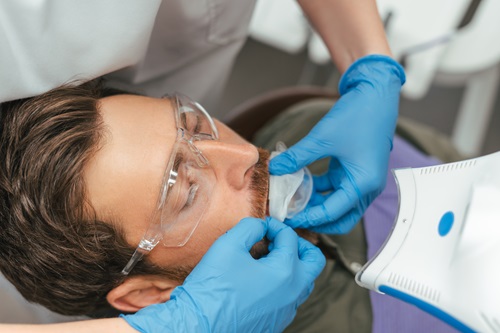Oral Dental Appliances for Sleep Apnoea: Non-Invasive Treatment Options

Are you one of many people who suffer from sleep apnoea? While it is a common sleep disorder, it is a matter that should not be taken lightly. Sleep apnoea manifests through loud snores or when a person experiences multiple pauses in breathing during sleep.
If this sleeping disorder is not addressed, it can lead to various health issues, which can include daytime fatigue, high blood pressure, heart problems, and even type 2 diabetes. Fortunately, we now have effective treatments available for this disorder, including oral dental appliances that are non-invasive. These devices offer a comfortable and convenient way to manage sleep apnoea and improve the quality of life for those affected.
Let’s explore each one.
Understanding Sleep Apnoea
Before we start with the dental appliances for sleep apnoea, let’s take a quick tour of what this sleep disorder is all about. Sleep apnoea occurs when the muscles in the back of the throat relax excessively, which narrows the airway or, sometimes, closes completely. This obstruction often happens during sleep, hence the name, and leads to multiple breathing pauses. Because the throat closes, it disrupts a person’s sleep and reduces oxygen levels in the blood.
There are two main types of sleep apnoea:
- Obstructive Sleep Apnoea (OSA): The most common type, where the airway becomes blocked during sleep, often due to soft tissue collapse in the throat.
- Central Sleep Apnoea: This less common form occurs when the brain fails to send proper signals to the muscles that control breathing, leading to disrupted breathing patterns.
- Complex Sleep Apnoea (CSA): A combination of both obstructive and central sleep apnoea.
While CPAP machines are a common treatment, they aren’t suitable for everyone. This is where oral dental appliances come in.
The Role of Oral Dental Appliances in Sleep Apnoea Treatment
Oral dental appliances are a non-invasive sleep apnoea treatment option that can be good treatment options for those with mild to moderate obstructive sleep apnoea. These are typically custom-made devices designed to be worn in the mouth during sleep. These oral appliances will help keep the airway open and prevent breathing interruptions.
One of the most common devices available for people with sleep apnoea is a Continuous Positive Airway Pressure (CPAP) machine. While these machines are a common treatment, they aren’t suitable for every sleep apnoea patient.
How Oral Dental Appliances Work
An oral dental appliance works by repositioning the lower jaw and tongue to keep the airway open during sleep. Using oral dental appliances for sleep apnoea also helps reduce the likelihood of airway obstruction, which allows uninterrupted breathing and a more restful sleep. These devices are typically made of acrylic and fit comfortably over the teeth, similar to a sports mouthguard or orthodontic retainer.
Mandibular Advancement Devices (MADs)
Mandibular Advancement Devices (MADs) are the most common type of oral appliance used to treat sleep apnoea. They work by gently shifting the lower jaw forward, which in turn pulls the tongue and soft tissues away from the back of the throat. This way, it can prevent getting the airway closed up.
MADs are typically made of acrylic and wire and feature a hinge mechanism that allows the dentist to adjust the forward positioning of the lower jaw. This precise adjustment is also crucial to maximise the effectiveness of the appliance. The goal of these devices is to achieve a balance between maintaining an open airway and providing comfort for the patient.
Tongue Retaining Devices (TRDs)
Tongue Retaining Devices (TRDs) are less common but can be effective for certain patients. They hold the tongue in a forward position, preventing it from obstructing the airway during sleep.
TRDs typically consist of an acrylic base that covers both dental arches, and a suction cup or vacuum system designed to hold the tongue in place. While these devices are less invasive than MADs, TRDs might not be suitable for everyone.
The reason behind this is that TRDs require a good seal between the appliance and the tongue to make it work. Also, different factors, such as the size and shape of the tongue, as well as the patient’s ability to tolerate the device, can influence the suitability of TRDs.
Who Can Benefit from Oral Dental Appliances?
Typically, oral dental appliances are recommended for individuals who suffer from mild to moderate obstructive sleep apnoea. They are great for:
- Individuals who find CPAP machines uncomfortable or intolerable.
- Those with mild to moderate obstructive sleep apnoea who prefer a non-invasive treatment option.
- People who frequently travel and need a portable, convenient solution for managing their sleep apnoea.
However, remember that not all people with sleep apnoea can benefit well from these oral dental appliances. Plus, those who have more complex conditions of sleep apnoea or certain dental conditions may be given different alternatives by their orthodontist—that’s why it’s essential to consult with a qualified dental professional to determine the most appropriate treatment option for your condition.
Embracing Non-Invasive Sleep Apnoea Treatment
Dealing with sleep apnoea can be a struggle for many individuals. And while CPAP machines are available, it can also be inconvenient to bring anywhere. Good thing there are different oral dental appliances available to help patients feel relieved and enhance the quality of their lives.
If you’re seeking a comfortable and effective solution for sleep apnoea, consider exploring oral dental appliances as a treatment option. Our team of experienced dental professionals at Blue Gum Dental is here to help you achieve restful sleep and better health.
Schedule a consultation today to learn how we can assist you in managing sleep apnoea with the right dental appliance.
